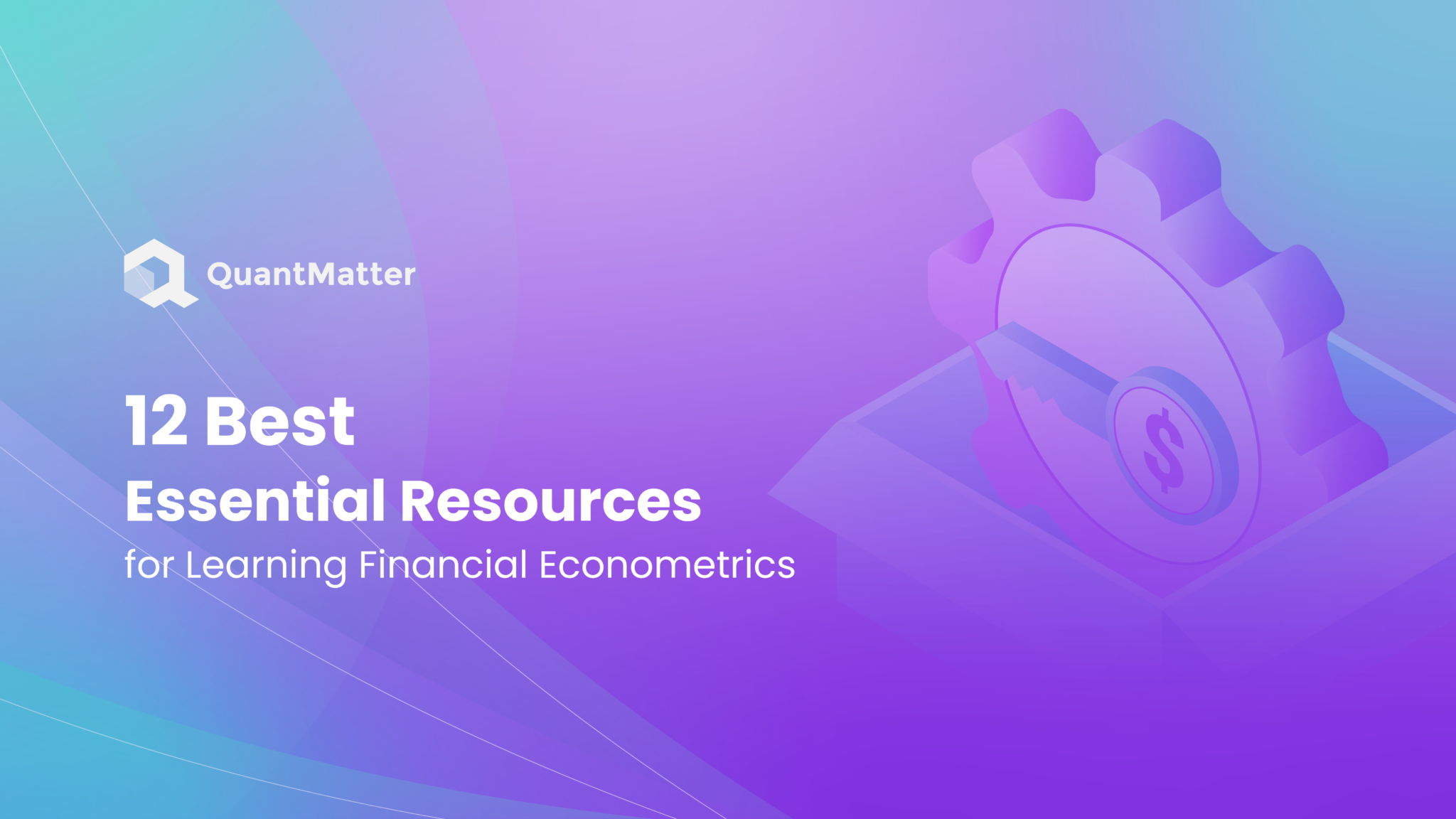
Financial econometrics is a fascinating field that combines finance, economics, and statistical methods to analyze financial markets and economic data. It plays a crucial role in understanding market behaviors, forecasting economic trends, and making informed financial decisions. Whether you are a student, a professional in finance, or someone looking to expand your knowledge, learning financial econometrics can provide valuable insights and skills. In this guide, we will explore the 12 best essential resources for learning financial econometrics.
These resources include books, online courses, tutorials, and practical tools that can help you master the concepts and techniques used in this field. By leveraging these resources, you can build a solid foundation in financial econometrics and apply your knowledge to real-world scenarios.
Moreover, we will delve into related topics such as the importance of financial econometrics, tips for effective studying, real-world applications, and career opportunities. Our aim is to provide a comprehensive guide that not only highlights the best resources but also helps you understand the broader context and practical implications of financial econometrics.
Why Learn Financial Econometrics?

Financial econometrics is an essential discipline for anyone involved in finance or economics. Understanding this field can offer numerous benefits and open up various opportunities. Here are some key reasons to learn financial econometrics:
- Enhanced Analytical Skills: Financial econometrics equips you with advanced analytical skills that are crucial for interpreting financial data. You’ll learn how to use statistical methods to analyze and forecast market trends, which can be invaluable for making informed investment decisions.
- Informed Decision-Making: By mastering financial econometrics, you can make more informed financial decisions. Whether you’re managing a portfolio, evaluating economic policies, or conducting financial research, the ability to analyze data accurately will improve your decision-making process.
Also Read: All About Algorithmic Trading That You Should Know!
- Better Risk Management: Understanding the principles of financial econometrics can help you identify and manage financial risks more effectively. You’ll be able to quantify risks, model financial markets, and develop strategies to mitigate potential losses.
- Career Advancement: Knowledge of financial econometrics is highly valued in many finance-related careers. Whether you’re aiming for a role in investment banking, asset management, or financial consulting, expertise in this field can set you apart from other candidates.
- Academic and Research Opportunities: For those interested in academia or research, financial econometrics offers a rich area of study. You can contribute to the development of new theories, models, and methods that advance our understanding of financial markets and economic behavior.
12 Best Essential Resources for Learning Financial Econometrics

When it comes to mastering financial econometrics, having access to the right resources is crucial. Here are the 12 best essential resources that can help you learn and excel in this field:
1. “Econometric Analysis” by William H. Greene
This comprehensive textbook provides an in-depth introduction to econometric theory and methods. It covers a wide range of topics including regression analysis, hypothesis testing, and model specification. Greene’s work is known for its clarity and depth, making it suitable for both beginners and advanced students. The book also includes numerous examples and exercises to illustrate key concepts and facilitate self-study.
2. “Introduction to Econometrics” by James H. Stock and Mark W. Watson
An excellent resource for beginners, this book offers a clear and accessible introduction to econometrics. It covers fundamental concepts such as simple and multiple regression, time series analysis, and panel data methods. Stock and Watson emphasize practical applications, providing real-world data examples and exercises that help students apply econometric techniques to actual economic problems. The book also includes a companion website with additional resources and datasets for practice.
3. “Financial Econometrics: Problems, Models, and Methods” by Christian Gourieroux and Joann Jasiak
This book focuses on the application of econometric methods to financial data. It provides a thorough overview of key models and techniques used in financial econometrics, including GARCH models, stochastic volatility, and factor models. Gourieroux and Jasiak’s approach is both theoretical and practical, offering insights into model implementation and interpretation. The book is particularly useful for those looking to apply econometric methods to areas such as risk management and asset pricing.
4. Coursera’s “Financial Econometrics” Course
Offered by top universities, this online course covers the fundamentals of financial econometrics. It includes video lectures, quizzes, and assignments to reinforce learning. The course typically starts with an introduction to econometric models and progresses to more advanced topics such as volatility modeling and time series analysis. Interactive elements such as peer-reviewed assignments and discussion forums enhance the learning experience and provide opportunities for feedback and collaboration.
5. edX’s “Introduction to Computational Finance and Financial Econometrics”
This online course provides a practical introduction to financial econometrics and computational finance. It’s designed for both beginners and those looking to deepen their knowledge. The course covers key topics such as risk modeling, portfolio optimization, and algorithmic trading. Interactive labs and coding exercises in R or Python allow students to apply theoretical concepts to real-world financial data. The course also includes assessments to test comprehension and provide a measure of progress.
6. MIT OpenCourseWare
MIT offers a range of free online courses and materials on econometrics and financial econometrics. These resources include lecture notes, assignments, and exams from actual MIT courses. Topics covered range from basic econometric methods to advanced time series analysis and financial modeling. The availability of these materials allows for flexible, self-paced learning, and the high quality of the content ensures a rigorous educational experience.
7. “Time Series Analysis” by James D. Hamilton
This book is a must-read for anyone interested in time series analysis, a crucial aspect of financial econometrics. It provides a thorough introduction to the subject with practical examples. Hamilton covers topics such as ARIMA models, unit roots, and cointegration, providing both theoretical foundations and practical applications. The book is suitable for students and practitioners alike, offering insights into the complexities of time-dependent data and how to model it effectively.
8. “The Econometrics of Financial Markets” by John Y. Campbell, Andrew W. Lo, and A. Craig MacKinlay
A classic in the field, this book explores the econometric techniques used to analyze financial markets. It’s a valuable resource for both students and professionals. The authors cover a range of topics including asset pricing models, market efficiency, and portfolio selection. Their approach is both rigorous and accessible, providing detailed explanations and empirical examples that demonstrate the application of econometric methods to financial market data.
9. DataCamp’s Financial Econometrics Courses
DataCamp offers a variety of interactive courses on financial econometrics and related topics. These courses combine video tutorials with hands-on coding exercises, making learning both engaging and practical. Topics covered include time series analysis, volatility modeling, and machine learning applications in finance. DataCamp’s platform allows learners to practice coding in R or Python directly in their browser, providing immediate feedback and a practical learning experience.
10. “Applied Econometric Times Series” by Walter Enders
This book focuses on the practical application of econometric methods to time series data. It’s suitable for both students and practitioners in finance and economics. Enders covers a range of topics including ARIMA models, cointegration, and error correction models. The book emphasizes practical applications, providing numerous examples and exercises that help readers apply econometric techniques to real-world data. The companion website offers additional resources and data sets for practice.
11. R and Python for Financial Econometrics
Learning to use statistical software like R and Python is essential for conducting econometric analysis. There are numerous online tutorials, courses, and books available to help you master these tools. Resources such as “R for Data Science” by Hadley Wickham and “Python for Data Analysis” by Wes McKinney provide comprehensive guides to using these programming languages for data analysis. Additionally, platforms like DataCamp and Coursera offer specialized courses in financial econometrics using R and Python.
12. “Quantitative Financial Economics” by Keith Cuthbertson and Dirk Nitzsche
This book provides a comprehensive introduction to the quantitative methods used in financial economics. It covers both theoretical and practical aspects of the subject, including asset pricing models, portfolio theory, and risk management. Cuthbertson and Nitzsche’s approach is accessible yet rigorous, making it suitable for both students and professionals. The book includes numerous examples, case studies, and exercises to reinforce learning and provide practical insights.
These resources will provide you with a solid foundation in financial econometrics and help you develop the skills needed to analyze financial data effectively. By exploring these books, courses, and tools, you’ll be well on your way to mastering this important field.
Practical Tools and Software for Financial Econometrics

Mastering financial econometrics involves not only understanding theoretical concepts but also using practical tools and software to analyze data. Here are some essential tools and software that can aid in your learning and application of financial econometrics:
1. R
R is a powerful statistical programming language widely used in data analysis and financial econometrics. It offers a vast array of packages and libraries specifically designed for econometric analysis. With R, you can perform tasks such as regression analysis, time series forecasting, and hypothesis testing. The R community is large and active, providing plenty of tutorials, forums, and resources to help you get started. Some popular packages for financial econometrics in R include quantmod, forecast, and rugarch.
2. Python
Python is another versatile programming language that is extensively used in financial econometrics. Its simplicity and readability make it a favorite among beginners and professionals alike. Python offers numerous libraries for econometric analysis, such as pandas, statsmodels, and scikit-learn. These libraries provide functions for data manipulation, statistical modeling, and machine learning. Python’s integration with other financial tools and its capability for automation make it a valuable tool for financial analysis and modeling.
3. EViews
EViews is a specialized econometric software that provides tools for statistical and econometric analysis. It is widely used in academia and industry for its user-friendly interface and powerful analytical capabilities. EViews supports a wide range of econometric models and techniques, including time series analysis, panel data analysis, and forecasting. It also offers robust data visualization tools, making it easier to interpret and present your results.
4. Stata
Stata is a comprehensive statistical software that is popular in social sciences, including finance and econometrics. It offers a wide range of statistical and econometric techniques, from basic descriptive statistics to advanced econometric modeling. Stata’s command syntax is straightforward, and it also provides a graphical user interface for ease of use. The software includes extensive documentation and an active user community, which can be helpful for learning and troubleshooting.
5. MATLAB
MATLAB is a high-level programming language and environment used for numerical computation, visualization, and programming. It is particularly useful for financial econometrics due to its powerful mathematical and statistical functions. MATLAB offers toolboxes specifically designed for econometric analysis, such as the Econometrics Toolbox, which includes functions for regression analysis, time series analysis, and hypothesis testing. MATLAB’s ability to handle large datasets and perform complex calculations makes it ideal for advanced econometric modeling.
6. Gretl
Gretl (Gnu Regression, Econometrics, and Time-series Library) is an open-source software package for econometric analysis. It is designed to be user-friendly and accessible to both beginners and experienced users. Gretl offers a wide range of econometric techniques, including linear and nonlinear regression, time series analysis, and panel data analysis. Its graphical user interface and comprehensive documentation make it a good starting point for those new to econometrics.
These tools and software provide the necessary capabilities to perform a wide range of econometric analyses. Whether you are analyzing time series data, modeling financial markets, or conducting hypothesis tests, these tools can help you implement and apply econometric techniques effectively.
Real-World Applications of Financial Econometrics
Financial econometrics has numerous real-world applications that make it a valuable field of study. By understanding and applying econometric methods, you can gain insights into financial markets, improve decision-making, and develop effective strategies. Here are some key real-world applications of financial econometrics:
1. Asset Pricing
One of the primary applications of financial econometrics is in asset pricing. Econometric models help in understanding how assets are priced in financial markets. By analyzing historical data and applying statistical methods, economists can identify factors that influence asset prices and develop models to predict future price movements. This is crucial for investors, portfolio managers, and financial analysts who need to value assets accurately and make informed investment decisions.
2. Risk Management
Risk management is another critical application of financial econometrics. Financial markets are inherently risky, and managing this risk is essential for financial institutions, corporations, and individual investors. Econometric models can quantify and analyze different types of risks, such as market risk, credit risk, and operational risk. By using these models, risk managers can assess potential losses, develop risk mitigation strategies, and ensure compliance with regulatory requirements.
3. Portfolio Optimization
Financial econometrics plays a significant role in portfolio optimization. The goal of portfolio optimization is to maximize returns while minimizing risk. Econometric techniques such as mean-variance optimization and the Capital Asset Pricing Model (CAPM) are used to determine the optimal asset allocation. By analyzing historical returns and covariances, investors can construct portfolios that achieve the desired risk-return tradeoff.
4. Economic Forecasting
Economic forecasting involves predicting future economic conditions based on historical data and econometric models. These forecasts are essential for policymakers, businesses, and investors. For example, central banks use econometric models to forecast inflation, unemployment, and GDP growth, which in turn informs their monetary policy decisions. Businesses use economic forecasts to plan investments, manage resources, and develop strategies to navigate economic cycles.
5. Event Studies
Event studies are used to assess the impact of specific events on financial markets. These events can include corporate actions (such as mergers, acquisitions, and earnings announcements), regulatory changes, and macroeconomic events (such as interest rate changes and geopolitical developments). Econometric techniques are used to measure the abnormal returns associated with these events and determine their significance. Event studies are valuable for investors, analysts, and policymakers who need to understand how events affect market prices and investor behavior..
These real-world applications demonstrate the importance and versatility of financial econometrics. By mastering econometric techniques, you can contribute to various areas of finance, enhance decision-making, and develop innovative solutions to complex financial problems.
Career Opportunities in Financial Econometrics
Financial econometrics offers a wide range of career opportunities in various sectors. Professionals with expertise in this field are highly sought after for their ability to analyze financial data, model economic relationships, and make data-driven decisions. Here are some of the key career paths available in financial econometrics:
1. Financial Analyst
Financial analysts play a crucial role in investment firms, banks, and corporations. They use econometric models to analyze financial data, forecast market trends, and evaluate investment opportunities. Financial analysts help businesses make informed decisions about investments, mergers and acquisitions, and other financial matters. Strong analytical skills and proficiency in econometric software are essential for success in this role.
2. Risk Manager
Risk managers are responsible for identifying, assessing, and mitigating financial risks within an organization. They use econometric techniques to quantify various types of risks, such as market risk, credit risk, and operational risk. By developing risk models and conducting stress tests, risk managers help organizations manage potential losses and ensure regulatory compliance. This role is critical in banks, insurance companies, and investment firms.
3. Quantitative Researcher
Quantitative researchers, often referred to as “quants,” develop and implement mathematical models to analyze financial markets and guide trading strategies. They work in hedge funds, investment banks, and proprietary trading firms. Quants use econometric methods to identify market inefficiencies, optimize portfolios, and develop algorithmic trading strategies. A strong background in mathematics, statistics, and programming is essential for this role.
Also Read: Mastering DAO Treasury Management for the Future of Finance
4. Economist
Economists analyze economic data to understand trends, forecast future economic conditions, and inform policy decisions. They work in government agencies, research institutions, and private sector organizations. Economists use econometric models to study various economic phenomena, such as inflation, unemployment, and GDP growth. Their insights help shape economic policies and business strategies.
5. Data Scientist
Data scientists leverage their skills in econometrics, statistics, and programming to extract insights from large datasets. In the financial sector, data scientists analyze market data, develop predictive models, and create data-driven strategies for investment and risk management. They work in a variety of settings, including financial institutions, fintech companies, and consulting firms. Proficiency in programming languages such as Python or R and experience with machine learning techniques are important for success in this role.
Conclusion
Financial econometrics is a powerful field that combines finance, economics, and statistical methods to analyze and interpret financial data. It plays a critical role in understanding market behaviors, forecasting economic trends, and making informed financial decisions. Whether you are a student, a professional in finance, or someone looking to expand your knowledge, mastering financial econometrics can provide valuable insights and skills.
In this guide, we explored the 12 best essential resources for learning financial econometrics, including comprehensive textbooks, online courses, and practical tools. We also discussed the importance of practical tools and software such as R, Python, EViews, Stata, MATLAB, Gretl, and Excel, which are essential for conducting econometric analysis. Furthermore, we highlighted real-world applications of financial econometrics, demonstrating its significance in asset pricing, risk management, economic forecasting, and more.
The diverse career opportunities available in financial econometrics, from financial analyst to quantitative researcher, underscore the value of this expertise. By leveraging the resources and tools discussed in this guide, you can build a solid foundation in financial econometrics and pursue a rewarding career in finance. Whether you’re analyzing financial data, developing econometric models, or making data-driven decisions, the skills you acquire will be invaluable in the ever-evolving world of finance.
Disclaimer: The information provided by Quant Matter in this article is intended for general informational purposes and does not reflect the company’s opinion. It is not intended as investment advice or a recommendation. Readers are strongly advised to conduct their own thorough research and consult with a qualified financial advisor before making any financial decisions.

Joshua Soriano
As an author, I bring clarity to the complex intersections of technology and finance. My focus is on unraveling the complexities of using data science and machine learning in the cryptocurrency market, aiming to make the principles of quantitative trading understandable for everyone. Through my writing, I invite readers to explore how cutting-edge technology can be applied to make informed decisions in the fast-paced world of crypto trading, simplifying advanced concepts into engaging and accessible narratives.
- Joshua Soriano#molongui-disabled-link
- Joshua Soriano#molongui-disabled-link
- Joshua Soriano#molongui-disabled-link
- Joshua Soriano#molongui-disabled-link
